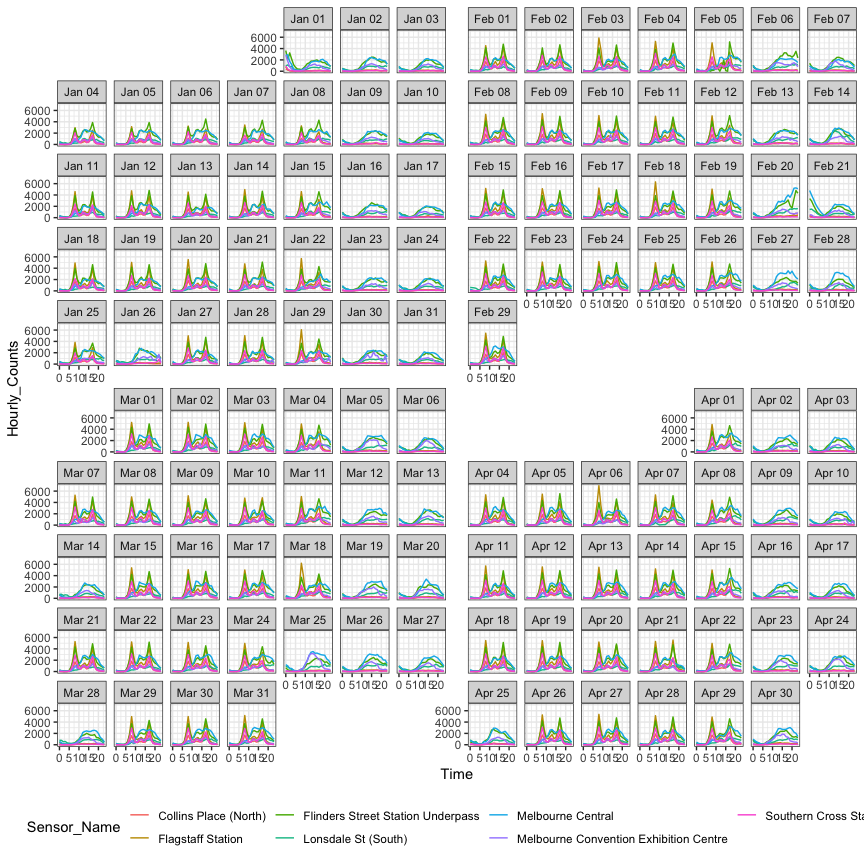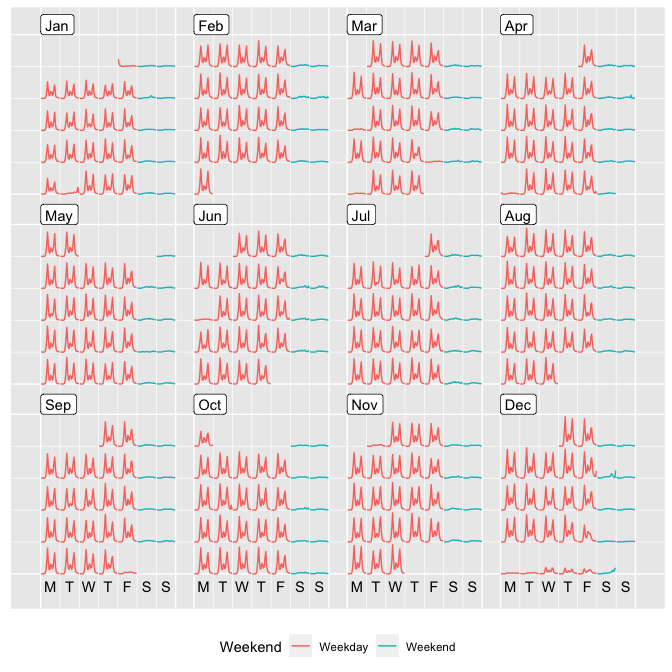The hardware and bandwidth for this mirror is donated by METANET, the Webhosting and Full Service-Cloud Provider.
If you wish to report a bug, or if you are interested in having us mirror your free-software or open-source project, please feel free to contact us at mirror[@]metanet.ch.
The goal of sugrrants is to provide supporting graphs with R for analysing time series data. It aims to fit into the tidyverse and grammar of graphics framework for handling temporal data.
You could install the stable version on CRAN:
install.packages("sugrrants")You could also install the development version from Github using:
# install.packages("remotes")
remotes::install_github("earowang/sugrrants")The fully-fledged faceting calendar facet_calendar()
unlocks day-to-day stories.
library(dplyr)
library(sugrrants)
hourly_peds %>%
filter(Date < as.Date("2016-05-01")) %>%
ggplot(aes(x = Time, y = Hourly_Counts, colour = Sensor_Name)) +
geom_line() +
facet_calendar(~ Date) + # a variable contains dates
theme_bw() +
theme(legend.position = "bottom")
On the other hand, the frame_calendar() provides tools
for re-structuring the data into a compact calendar layout, without
using the faceting method. It is fast and light-weight, although it does
not preserve the values.
p <- hourly_peds %>%
filter(Sensor_ID == 9, Year == 2016) %>%
mutate(Weekend = if_else(Day %in% c("Saturday", "Sunday"), "Weekend", "Weekday")) %>%
frame_calendar(x = Time, y = Hourly_Counts, date = Date) %>%
ggplot(aes(x = .Time, y = .Hourly_Counts, group = Date, colour = Weekend)) +
geom_line() +
theme(legend.position = "bottom")
prettify(p)
This package is part of the project—Tidy data structures and visual methods to support exploration of big temporal-context data, which has been participated in Google Summer of Code 2017 (gsoc), for R project for statistical computing.
A new function frame_calendar() [here
and here]
in the sugrrants package has been developed and
documented for calendar-based graphics. I have also written a vignette
[source
and reader
view], which introduces and demonstrates the usage of the
frame_calendar() function. Many
unit tests have been carried out to ensure the expected performance
of this function. The function implements non-standard evaluation and
highlights the tidy evaluation in
action. The initial release (v0.1.0) of the package has been published
on CRAN
during the gsoc summer time.
I have initialised a new R package tsibble
for tidy temporal data, as part of the project. The
tsibble() function constructs a new tbl_ts
class for temporal data, and the as_tsibble() helps to
convert a few ts objects into the tbl_ts
class. Some key verbs (generics) from the dplyr
package, such as mutate(), summarise(),
filter(), have been defined and developed for the
tbl_ts data class. The tsibble package was
highly experimental over the period of the gsoc [commits],
and these functions are very likely to be changed or improved in the
future.
walk_melb()
and shine_melb(),
have been written and documented as the v0.1.0 and v0.2.0 releases on
CRAN. The majority of the code for the function run_melb()
has been done, but the interface needs improving after the gsoc.
The acronym of sugrrants is SUpporting GRaphs with R for ANalysing Time Series, pronounced as “sugar ants” that are a species of ant endemic to Australia.
Please note that this project is released with a Contributor Code of Conduct. By participating in this project you agree to abide by its terms.
These binaries (installable software) and packages are in development.
They may not be fully stable and should be used with caution. We make no claims about them.